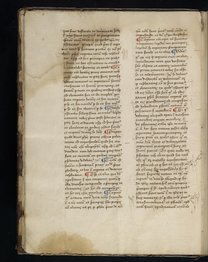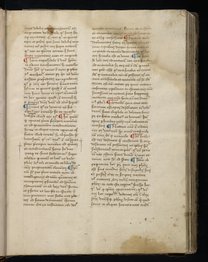Pretiosa margarita novella
The Precious New Pearl
- Circa 1450 – 1480

Rights
Download all 192 images
PDFZIPof full-sized JPGsDownload selected image
Small JPG1200 x 1511px — 317 KBLarge JPG2880 x 3625px — 1.9 MBFull-sized JPG3844 x 4839px — 3.3 MBOriginal fileTIFF — 3844 x 4839px — 53.3 MBThis is one of only six known complete manuscripts of a 14th-century alchemical treatise; all the extant manuscripts date from the 15th century or later. This copy includes lengthy contemporary glosses, possibly additions to the text, and notes in at least two hands.
The script, watermark, and binding support an origin in the Iberian Peninsula in Catalonia, circa 1450-1480, an origin also suggested by the Spanish spelling of alchemy, alquimia (for example, folio 3, last line; the more common alkimia is also used).
Pretiosa margarita novella is a discussion of the arguments for and against alchemy. The author, Petrus Bonus, cites numerous earlier writers, including Aristotle, Avicenna, and Galen, as well as the body of alchemical theory from the ancient world—Geber, Morienus, Haly, and Rasis, among others. He discusses terminology and refutes arguments against alchemy. His discussion of the philosopher’s stone and transmutation is in keeping with other 14th-century treatises and emphasizes the importance of quicksilver, or mercury. Although he states at the beginning that the whole of the alchemical art can be taught in one day—and even one hour—he confesses that he himself had not yet penetrated the secret, or experienced the philosopher's stone directly.
Little is known about the author of this text beyond his name, Petrus Bonus (or Pietro Buono), and his origin in Lombardy in Ferrara (he is sometimes called Bonus of Ferrara). Bonus states that he wrote the text in Pola (now Pula), a town in Istria, in 1330, according to most manuscripts, although the copy of the text described here lists the date as 1338, and others record the date as 1339. The author also states that he discussed similar questions in Traù in Dalmatia in 1323. Since he is described as "physicus" i.e., a doctor of medicine, it is likely that he studied medicine at a university. The date given in the manuscripts has been questioned, since no 14th-century manuscripts survive, and it has been suggested that the author may be identified with Petrus Bonus Advogarius, who taught astronomy and physics in Ferrara in the last third of the 15th century. Nonetheless, modern scholars, following Lynn Thorndike, are in agreement that the internal evidence of the text supports a 14th-century date, and that the attribution to the later author is unwarranted.
| Property | Value |
|---|---|
| Author | |
| Place of creation | |
| Format | |
| Genre | |
| Extent |
|
| Language | |
| Subject | |
| Rights | Public Domain Mark 1.0 |
| Credit line |
|
Institutional location
| Department | |
|---|---|
| Collection | |
| Physical container |
|
Related Items
Cite as
Bonus, Petrus. “Pretiosa Margarita Novella,” circa 1450–1480. Othmer MS 3. Science History Institute. Philadelphia. https://digital.sciencehistory.org/works/pn89d712c.
This citation is automatically generated and may contain errors.






















































